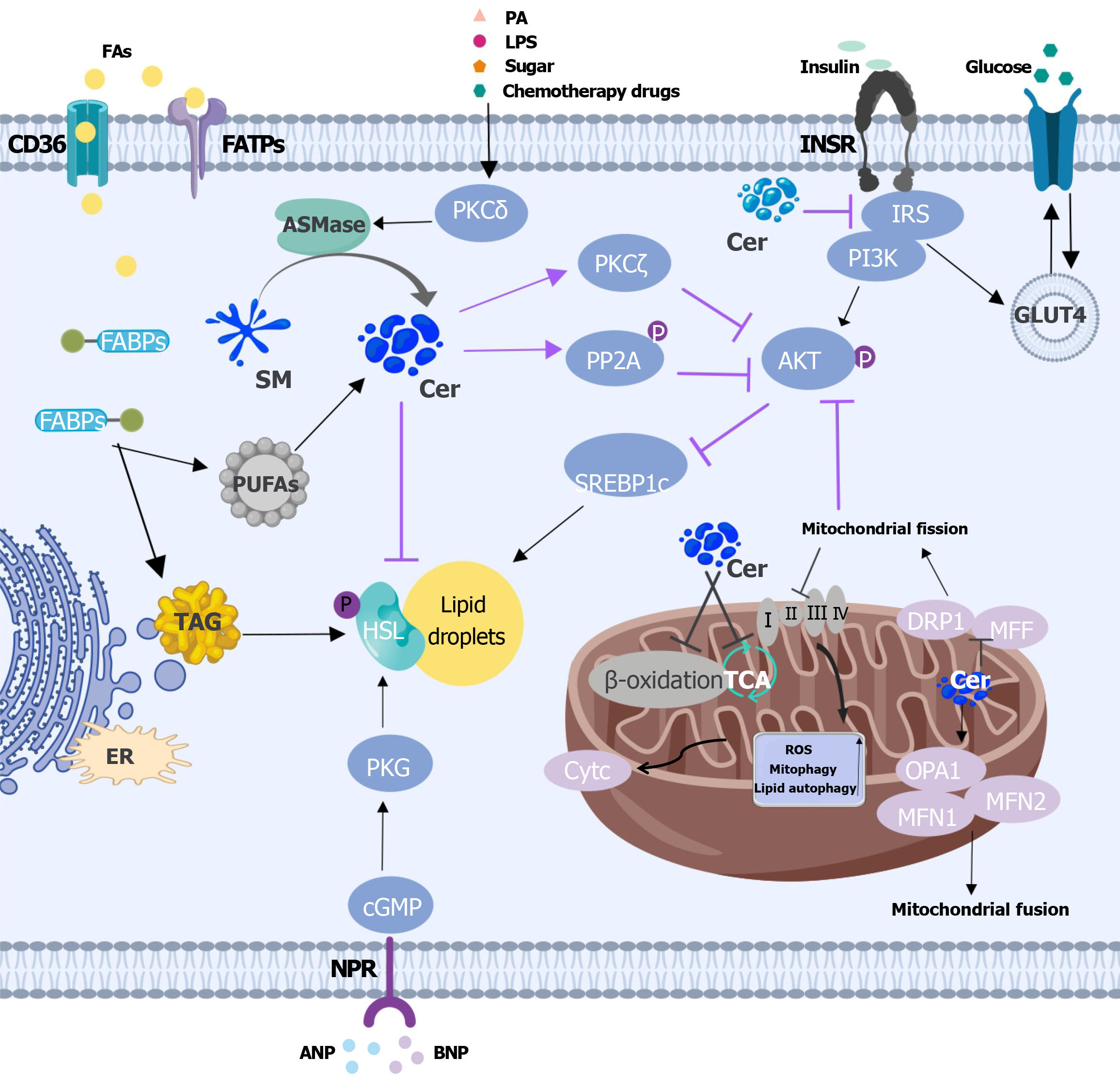Copyright
©The Author(s) 2025.
World J Cardiol. Feb 26, 2025; 17(2): 102308
Published online Feb 26, 2025. doi: 10.4330/wjc.v17.i2.102308
Published online Feb 26, 2025. doi: 10.4330/wjc.v17.i2.102308
Figure 1 The acid sphingomyelinase/ceramide pathway regulates glycolipid metabolism and mitochondrial homeostasis in liver, fat, and skeletal muscle cells.
Palmitic acid, lipopolysaccharides, sugar, chemicals can activate acid sphingomyelinase via protein kinase C delta, causing an increase in ceramide (Cer). Oxidative stress/mitochondrial stress (endoplasmic reticulum) and polyunsaturated fatty acids also cause Cer accumulation. Cer reduces AKT activity through the mechanism of protein kinase C delta zeta and protein phosphatase 2A, increases SREBP1c expression, and affects glucose and Cer can also affect insulin receptor substrate signalling, thereby affecting PI3K/AKT and glucose transporters type 4 and reducing glucose uptake. Cer can increase the permeability of CD36 and fatty acid transport proteins to fatty acids, increasing TAG synthesis, and also inhibit hormone-sensitive triglyceride lipase enzyme activity, decreasing TAG catabolism. And atrial natriuretic peptide and brain natriuretic peptide can activate HSLase through cyclic guanosine mono-phosphate/protein kinase G. In mitochondria, Cer affects the mitochondrial respiratory chain, β-oxidation, and the tricarboxylic acid cycle causing decreased ATP synthesis decreased ATP production, elevated reactive oxygen species, lipid autophagy, and mitochondrial autophagy. Cer can affect the respiratory chain protein complex II affecting membrane permeability, and pro-apoptotic substances (e.g., cytochrome c) are released from mitochondria. Cer is released from mitochondria through an increase in the dynamin-related protein 1 expression, decreasing mitochondrial fusion protein 1 and optic atrophy protein 1 expression, increasing mitochondrial fission and decreasing fusion. FAs: Fatty acids; PA: Palmitic acid; LPS: Lipopolysaccharides; FATPs: Fatty acid transport proteins; ASMase: Acid sphingomyelinase; PKC: Protein kinase C; INSR: Insulin receptor; Cer: Ceramide; IRS: Insulin receptor substrate; PI3K: Phosphatidylinositol 3-kinase; FABPs: Fatty acid-binding proteins; SM: Sphingomyelin; PP2A: Protein phosphatase 2A; AKT: Protein kinase B; GLUT4: Glucose transporters type 4; PUFAs: Polyunsaturated fatty acids; SREBP1c: Sterol regulatory element binding protein 1c; TAG: Triacylglycerol; HSL: Hormone-sensitive triglyceride lipase; DRP1: Dynamin-related protein 1; MFF: Mitochondrial fission factor; ER: Endoplasmic reticulum; PKG: Protein kinase G; cGMP: Cyclic guanosine mono-phosphate; ROS: Reactive oxygen species; OPA1: Optic atrophy protein 1; MFN1: Mitochondrial fusion protein 1; MFN2: Mitochondrial fusion protein 2; NPR: Natriuretic peptide receptors; ANP: Atrial natriuretic peptide; BNP: Brain natriuretic peptide.
- Citation: Wang HN, Wang Y, Zhang SY, Bai L. Emerging roles of the acid sphingomyelinase/ceramide pathway in metabolic and cardiovascular diseases: Mechanistic insights and therapeutic implications. World J Cardiol 2025; 17(2): 102308
- URL: https://www.wjgnet.com/1949-8462/full/v17/i2/102308.htm
- DOI: https://dx.doi.org/10.4330/wjc.v17.i2.102308









